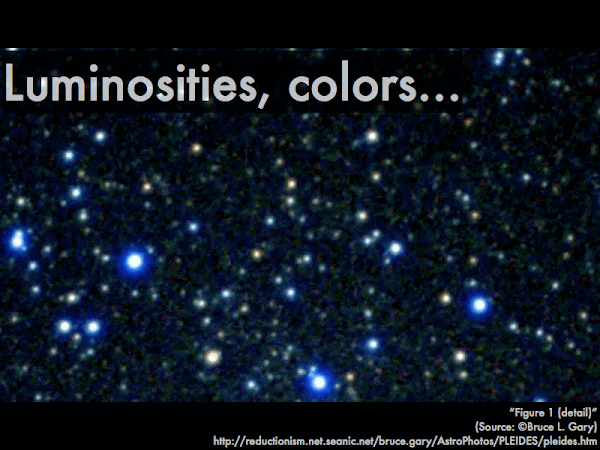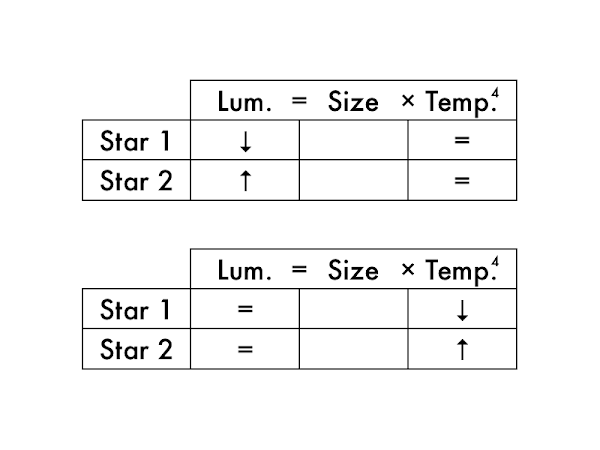Cuesta College, San Luis Obispo, CA
Students have a weekly online reading assignment (hosted by SurveyMonkey.com), where they answer questions based on reading their textbook, material covered in previous lectures, opinion questions, and/or asking (anonymous) questions or making (anonymous) comments. Full credit is given for completing the online reading assignment before next week's lecture, regardless if whether their answers are correct/incorrect. Selected results/questions/comments are addressed by the instructor at the start of the following lecture.
The following questions were asked on reading textbook chapters and previewing presentations on parallax, distance, apparent magnitude, absolute magnitude, Wien's law and the Stefan-Boltzmann law.

Selected/edited responses are given below.
Describe something you found interesting from the assigned textbook reading or presentation preview, and explain why this was personally interesting for you.
"That astronomers use triangulation to calculate the distance of a star. It is nice to see this practical application of trigonometry which, interestingly, can be compared to how surveyors calculate distance as well."
"I found the whole chapter pretty interesting, especially how the color really shows the temperature of the star. This is mostly due to the fact that we usually see blue and white as cool colours, so when it turns out that they're in fact indicators of the hottest suns it seems somewhat counter intuitive. Even though I know blue flames are hotter than red flames, it still seems so odd."
"The Stefan-Boltzamann law, because I was trying to figure out all the concepts (luminosity, temperature, and size) how they all come together to determine different things about the stars."
"How bigger stars aren't necessarily hotter."
"That you can tell which star has the most luminosity based on it's color and size. This is interesting because I didn't know it was so simple as this."
"The charts for determining the luminosity of stars was cool. I didn't think it would be that easy, but it makes sense and is really quick to do!"
"It's cool to know that I'm not crazy or seeing things when I see a star as having a red color."
Describe something you found confusing from the assigned textbook reading or presentation preview, and explain why this was personally confusing for you.
"How can we measure the distances to stars?"
"The Stefan-Boltzamann law because I feel I still need examples to understand it completely and be able to use it."
"Apparent magnitude and absolute magnitude. It's hard to conceptualize."
"I was confused about what I found to be interesting. That is, why we don't see stars of all colors of the rainbow."
"Light-years and parsecs. I get that they ares a units of measure but why did we choose them? What would be an examples of them?"
Explain how apparent magnitude and the absolute magnitude are defined differently.
"Apparent magnitude is what we see from Earth. Absolute is what the actual brightness is."
Suppose the sun was moved to a distance of 10 parsecs away. As a result, its __________ magnitude would become dimmer.
absolute. *** [3] apparent. ****************** [18] (Both of the above choices.) ** [2] (Neither of the above choices.) ** [2] (Unsure/guessing/lost/help!) **** [4]
Rank the temperatures of these stars (1 = hottest, 4 = coolest; there are no ties).
(Only correct responses shown.)
Hottest: blue main sequence star [70%]
Second hottest: white main sequence star [59%]
Third hottest: yellow main sequence star [83%]
Coolest: red main sequence star [90%]
Rank the temperatures of these stars (1 = hottest, 4 = coolest; there are no ties).
(Only correct responses shown.)
Hottest: blue supergiant [83%]
Second hottest: white dwarf [59%]
Third hottest: yellow supergiant [72%]
Coolest: red dwarf [93%]

dimmer. *** [3] brighter. ************************** [26] (These stars would be the same size.) [0] (Unsure/guessing/lost/help!) [0]
Two stars (equally far away) have the same brightness, but one star is cooler, and the other star is hotter. The __________ star will be larger in size.
cooler. ************** [14] hotter. ************** [14] (These stars would be the same size.) [0] (Unsure/guessing/lost/help!) * [1]
Ask the instructor an anonymous question, or make a comment. Selected questions/comments may be discussed in class.
"How do they know the temperature of a star?" (By looking at its color.)
"Could we please briefly discuss in class the relationship between a star's color and its temperature?"(Yes.)
"What's up with your hearing aid?" (I'm the world's deafest swing DJ. #fml #strongthanhearingloss)
No comments:
Post a Comment